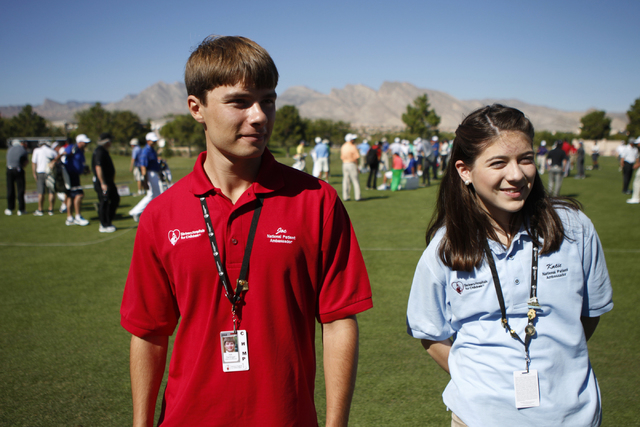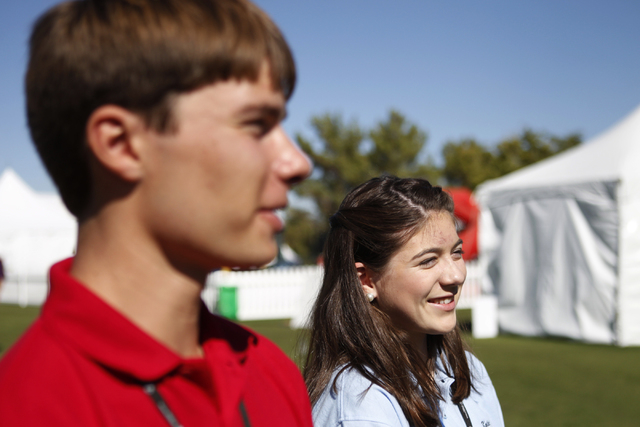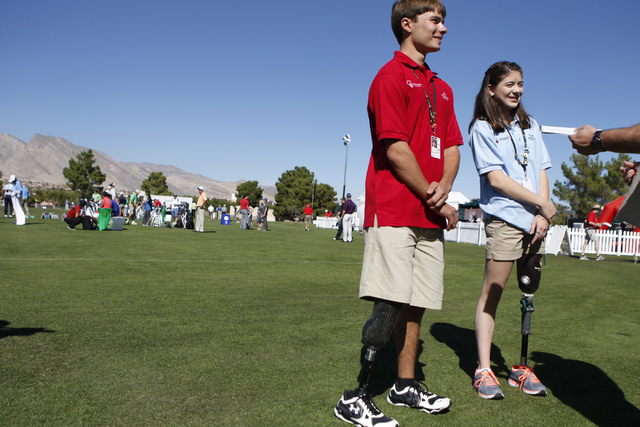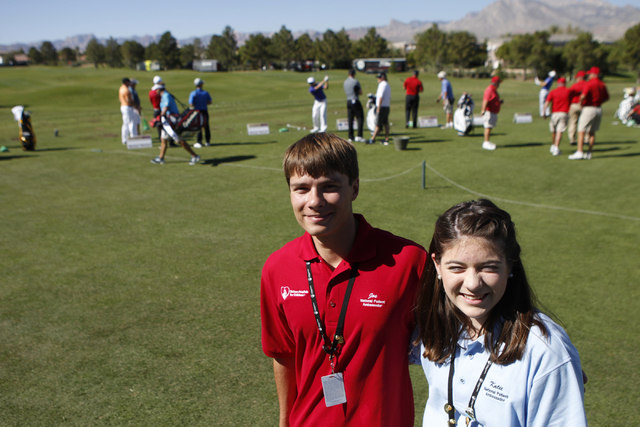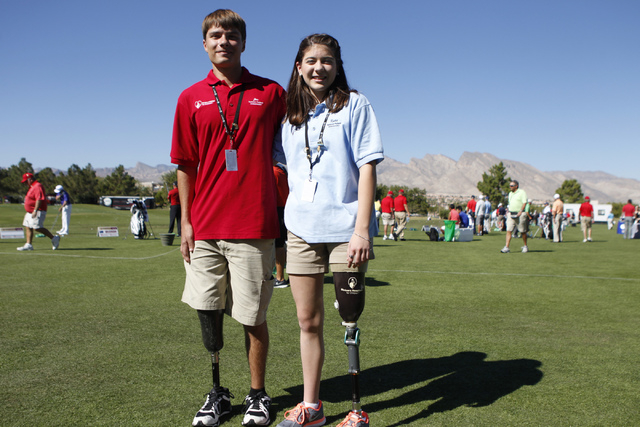Youths’ attitude is difference — positively
Katie Ladlie loves her T-shirt that reads: “This Shirt Cost Me an Arm and a Leg.”
Problem for those reading the front of her gray tee with big, bold, black letters is they might be distracted by her prosthetic left leg.
“I deal with my situation with humor,” Ladlie, 16, said Wednesday morning at TPC Summerlin. “It’s just humor that helps people feel comfortable, because if you can’t laugh at yourself, then other people can’t laugh with you.”
Ladlie and Joe Dertinger, 18, are doing their best this week as the national patient ambassadors for the Shriners Hospitals for Children Open to make everyone attending feel comfortable while raising awareness about the organization’s North American facilities.
Ladlie, who lives in St. Louis, was diagnosed with an unusual vascular malformation of her left leg shortly after birth. As debilitating pain caused by her deteriorating knee cartilage worsened, doctors from her locally based Shriners Hospital gave her two options: knee fusion (which would permanently straighten her leg) or an above-the-knee amputation. She chose to have the amputation, and couldn’t be any happier four years later.
“I notice a couple of the other patients deal with (their disability) in different ways, but I think we all think the same, that we’ve been dealt with (our situations) and we all handle it the best way we can,” she said. “You just have to make the best of the situation.”
Dertinger was born with a rare condition that involved all four of his extremities: a short tibia and no fibula on his right leg, a ball and socket type ankle on his left leg, just three toes on his right foot, and his hands each developed with just two fingers and a thumb. On his right hand, the fingers were webbed together. At 15 months old, he underwent surgeries to separate the fingers on his right hand and amputate his right foot so that a prosthesis would fit better.
Considering everything he has endured, Dertinger’s amazing attitude and outlook mirrors Ladlie’s, as he agrees there’s been no better way than to deal with the situation than to stay positive about his life and what he does have going for himself.
“From my own experience, I kind of think of it as this is the life I’m given, this is the situation I’m presented with, so adapt to it and make the best of it,” said Dertinger, who lives in Waconia, Minn., which is about one hour west of the Twin Cities. “I think everybody that I see walking around with prosthetics or in a wheelchair, I think they’re thinking the same thing: ‘This is what I have, so make the best of it.’ (And) I think we’re all kind of in the same boat, where when we look at other people that don’t have disabilities and we can see that they’re feeling bad for us, they really shouldn’t because we’re still living our lives the way we want.”
And it’s their philosophies that brought them to TPC Summerlin this week.
“It’s an amazing feeling to be a national ambassador and to be blessed to do all these amazing things,” Ladlie said. “It’s just amazing to go around and meet all the different people and help awareness for the hospital and help raise money for it. It’s just so cool to be a part of this.”
Said Dertinger: “It’s really an honor to be able to represent all of the Shriners and their families that have done so much for me and my family, as well as represent all of the patients, and all of the past, present and future patients, as well as raising awareness and getting support for expanding the hospital system and helping more children be able to reach their potential.”
Dertinger is a prime example of striving for an athletic potential on a Paralympic level, as he’s been skiing since he was 5. He eventually took up racing at 9, and since then has traveled the country to highly competitive racing events — including the acclaimed Hartford Ski Spectacular in Breckenridge, Colo. — and has trained with the U.S. Paralympic team.
All on one leg.
Ladlie recently joined the Disabled Athlete Sports Association Blues sled hockey team and is looking forward to competing in a tournament this month. Though she says she has a lot to learn on the ice, she has enjoyed being a part of DASA, which teaches kids how to deal with their situation in different sports.
Since becoming a part of the athletic organization, the die-hard St. Louis Cardinals fan who hopes her favorite team reaches the World Series has competed in a triathlon, learned to swim and learned how to be a participant for her high school track team.
The recurring theme during a conversation with the young ambassadors — along with their inspiring stories and perseverance — was the humor that exudes from the personal stories they share about their disabilities, and the fun they poke at themselves for the pure shock value they get out of others.
For instance, both can’t wait for Halloween, as Ladlie is looking to one-up a previous costume as Leg Lamp from Christmas Story by creating an actual “peg leg” so she can dress up as a pirate. Dertinger has taken things a bit further in the past, recruiting his father for some eerie haunted-house thrills at the expense of others.
As part of a haunted hay ride through a church event — yes, church — they had an act during which his father chased him with a chainsaw. Dertinger would fall and push his leg off a little bit, while his father pretends to cut it off with the roaring power tool, and shiny red tinsel hung off the prosthesis, leaving a bloody and mangled scene for stunned visitors.
“I would just be laying on the ground screaming bloody murder,” Dertinger said. “Just (having) fun messing around, stuff like that, where people don’t expect it, because they’re (normally) thinking ‘we feel bad for him because that’s what he has.’ But if you’re making fun of yourself like that, really it’s at nobody else’s expense but yours. If you can laugh at yourself, that makes it better.”
Said Ladlie: “Having one leg, it’s kind of funny sometimes with all the things you can do. You can flip your leg around and scare people, fun things like that, you just have to make the best of it. It helps make people more comfortable with the situation, knowing that they can joke around with you. They don’t have to walk on broken glass. I was born like this, and you just have to make the best of it.”
They also know when it’s time to take their disabilities seriously, and part of that is not only making sure other adolescent children are aware of their potential, but that parents stay upbeat for their kids as well.
“Have faith in the doctors, that they know what they’re doing,” Dertinger said. “And if they have a case such as mine, where it’s just an amputation of a leg or another limb, and allowing a prosthetic to fit better or a similar situation, the technology is there and prosthetics will allow the child to live their lives to be the best they can be. Don’t be afraid.”
Said Ladlie: “Kids can do anything; they want to be kids. Treat them like any normal kids. I know my parents, (when) I try to pull the ‘gimp’ card on them, they won’t have any of that. I have three other siblings, and they treat me just as normal as the other siblings. Just treat your kid as normal as possible. They might have some limitations, but know that they’re able to do anything. Try them out for sports. They might love it. Just treat them more like a normal kid.”



